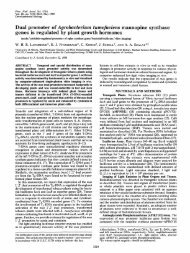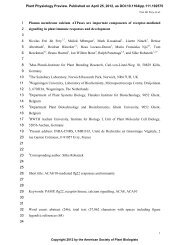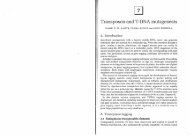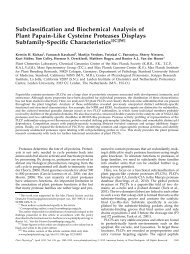A Conserved Domain of the Arabidopsis GNOM ... - The Plant Cell
A Conserved Domain of the Arabidopsis GNOM ... - The Plant Cell
A Conserved Domain of the Arabidopsis GNOM ... - The Plant Cell
Create successful ePaper yourself
Turn your PDF publications into a flip-book with our unique Google optimized e-Paper software.
354 <strong>The</strong> <strong>Plant</strong> <strong>Cell</strong><br />
Schmid (1994). RCM-T1 was unfolded in 0.1 M Tris-HCl, pH 8.0, at<br />
15C. <strong>The</strong> acceleration <strong>of</strong> <strong>the</strong> refolding rate <strong>of</strong> RCM-T1 was determined<br />
(Mücke and Schmid, 1994). Briefly, refolding was initiated at<br />
15C by a 67-fold dilution <strong>of</strong> unfolded protein to final conditions <strong>of</strong><br />
0.1 M Tris-HCl, pH 8.0, 2 M NaCl, 0.7 M RCM-T1, and <strong>the</strong> desired<br />
concentrations <strong>of</strong> GST–Cyp5 19–201 or GST diluted in <strong>the</strong> same buffer.<br />
Refolding reactions were monitored by <strong>the</strong> change in protein fluorescence<br />
at 320 nm (10-nm band width) after excitation at 268 nm<br />
(1.5-nm band width) by using a Hitachi F-3010 fluorescence spectrophotometer<br />
(Hitachi, Tokyo, Japan). Small contributions <strong>of</strong> GST–<br />
Cyp5 fusion protein, GST, or cyclosporin A to fluorescence were determined<br />
and subtracted from <strong>the</strong> values in individual experiments.<br />
Generation <strong>of</strong> Antibodies to Cyp5, Immunoblotting,<br />
and Immunolocalization<br />
Figure 9. Immunolocalization <strong>of</strong> Cyp5 during Embryogenesis.<br />
Whole-mount preparations <strong>of</strong> embryos were stained with (A) preimmune<br />
serum (1:3000; control) or (B) to (D) anti-Cyp5 peptide antiserum<br />
(1:3000) followed by Cy3-conjugated secondary antibody (goat<br />
anti–rabbit; Dianova, Hamburg, Germany). Images represent internal<br />
optical sections generated by confocal microscopy. Stages <strong>of</strong> embryogenesis<br />
(Jürgens and Mayer, 1994) are shown in (A) to (D). Asterisks,<br />
basal end <strong>of</strong> embryo; bracket, epidermal cell layer.<br />
(A) Mid-globular-stage embryo.<br />
(B) Early-globular-stage embryo.<br />
(C) Late globular/triangular–stage embryo.<br />
(D) Early-heart-stage embryo. Note <strong>the</strong> low intensity <strong>of</strong> signal in <strong>the</strong><br />
epidermal layer (bracket).<br />
Measurement <strong>of</strong> Peptidylproplyl cis/trans–Isomerase Activity<br />
Peptidylproplyl cis/trans–isomerase (PPIase) activity <strong>of</strong> fusion proteins<br />
was determined by protease-coupled assay by using tetrapeptide<br />
substrate Suc-Ala-Ala-Pro-Phe-4-nitroanilide (Fischer et al.,<br />
1989). Reactions were performed in 35 mM Hepes (Sigma), pH 7.8,<br />
at 10C, and monitored at 390 nm. Equipment and methods for calculation<br />
<strong>of</strong> enzyme activity were as described previously (Hani et al.,<br />
1999). Reactions containing 2 10 5 M substrate and desired concentrations<br />
<strong>of</strong> fusion protein (0 to 30 nM) were started by addition <strong>of</strong><br />
chymotrypsin to a final concentration <strong>of</strong> 13 M. Inhibition <strong>of</strong> PPIase<br />
activity was measured by incubating cyclosporin A (Calbiochem)<br />
with <strong>the</strong> enzyme in <strong>the</strong> reaction mixture for 5 min before starting <strong>the</strong><br />
reaction by addition <strong>of</strong> <strong>the</strong> substrate and chymotrypsin.<br />
Protein Refolding Experiments<br />
For protein refolding experiments, ribonuclease T1 variant RCM-T1<br />
(Ser-54-Gly/Pro-55-Asn) was prepared as described by Mücke and<br />
A Cyp5-specific nonconserved peptide YKIEAEGKQSGTPKS (amino<br />
acids 175 to 189) was selected for antibody generation. This peptide<br />
was syn<strong>the</strong>sized with an additional N-terminal cysteine, purified, and<br />
coupled to KLH at Eurogentec (Seraing, Belgium). Freund’s adjuvant<br />
containing 3 mg <strong>of</strong> <strong>the</strong> KLH peptide was injected into rabbit followed<br />
by a booster shot with <strong>the</strong> same amount <strong>of</strong> incomplete Freund’s adjuvant<br />
4 weeks later. Serum was collected and tested as described<br />
by Lauber et al. (1997). For specificity control, antipeptide antiserum<br />
was preincubated with peptide or <strong>the</strong> purified native GST–Cyp5 19–201<br />
fusion in 2% BSA and PBS for <strong>the</strong> time used for blot incubation (1 hr)<br />
before immunodetection. Competition assays for immunocytochemistry<br />
included preincubation <strong>of</strong> 1 mL <strong>of</strong> 1:3000 antipeptide serum in<br />
2% BSA with 20 g <strong>of</strong> GST–Cyp5 19–201 coupled to 100 L <strong>of</strong> glutathione–Sepharose<br />
beads. Anti-Cyp5 antibodies were removed by<br />
pelleting beads, and supernatant was used as a control in immunostaining.<br />
Materials and procedures for cell fractionation, immunoblot<br />
analysis, immunolocalization, and image processing were described<br />
previously (Lauber et al., 1997; Steinmann et al., 1999).<br />
<strong>Plant</strong> Growth and <strong>Cell</strong> Culture<br />
<strong>Arabidopsis</strong> wild-type (Landsberg erecta) and gnom alleles, conditions<br />
for plant growth, and generation and maintainance <strong>of</strong> <strong>Arabidopsis</strong><br />
suspension cell cultures were described previously (Mayer et<br />
al., 1991, 1993; Busch et al., 1996; Steinmann et al., 1999).<br />
ACKNOWLEDGMENTS<br />
We thank Roger Brent for providing <strong>the</strong> yeast strains and vectors for<br />
<strong>the</strong> interaction trap version <strong>of</strong> <strong>the</strong> two-hybrid system, Jörg Grosshans<br />
and Stefan Sigrist for advice on analysis <strong>of</strong> protein interactions, Paul<br />
Dupree for <strong>the</strong> Myc-sialyl transferase line, Franz X. Schmid for a gift<br />
<strong>of</strong> <strong>the</strong> RNase T1 variant, Jörg Fanghänel for help on RCM-T1 refolding<br />
assays, Agnes Hepp and Roger Grau for technical assistance,<br />
Heinz Schwarz for advice on antibody generation and for immunizing<br />
rabbits, and Niko Geldner, Maren Heese, Michael Lenhard,<br />
Ulrike Mayer, Birgit Schwab, and Georg Strompen for critical reading<br />
<strong>of</strong> <strong>the</strong> manuscript. This work was supported by <strong>the</strong> Deutsche<br />
Forschungsgemeinschaft through Grant No. Ju 179/3-4 and a Leibniz<br />
award to G.J.






